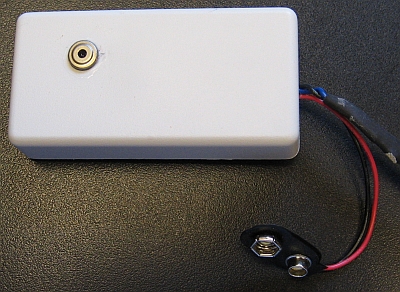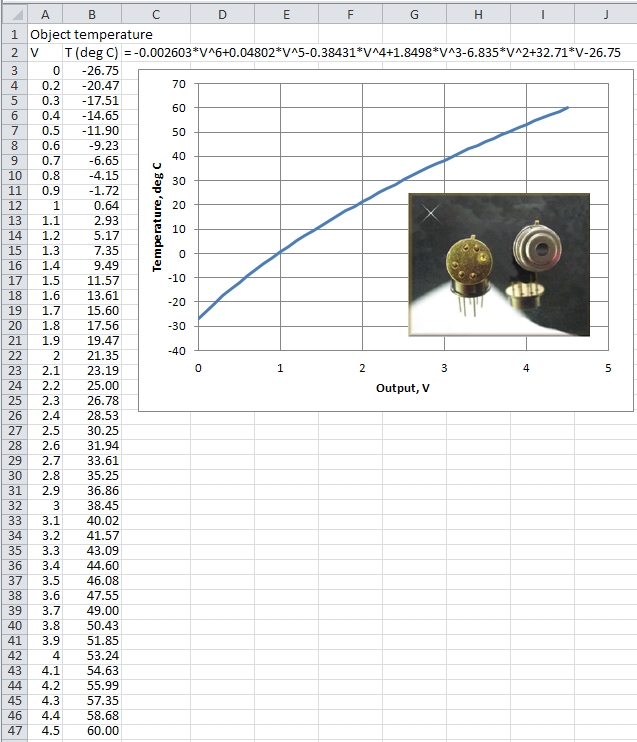The IESRE IR temperature sensor
Description
 The IESRE IR temperature sensor is based on the Excelitas TPS 1T 034 OAA060 thermopile sensor. It comes in several versions. The one shown here and used in this device infludes a built-in op amp that is pre-calibrated with a polynomial conversion from output voltage to temperature in °C. It has a field of view of about 60°. These detectors are similar to the ones used in commercial non-contact IR thermometers. Its spectral response is shown in the image.
The IESRE IR temperature sensor is based on the Excelitas TPS 1T 034 OAA060 thermopile sensor. It comes in several versions. The one shown here and used in this device infludes a built-in op amp that is pre-calibrated with a polynomial conversion from output voltage to temperature in °C. It has a field of view of about 60°. These detectors are similar to the ones used in commercial non-contact IR thermometers. Its spectral response is shown in the image.

The circuit includes a 5-V DC regulator to power the sensor. IESRE usually uses the HOBO U12 USB loggers from Onset Computer Corporation to record data. These devices have a range of 0—2.5 V, but the output range of the TPS 1T 034 OAA060 sensor is more than 2.5 V for temperatures above about 30°C. Also, the input impedance of the HOBO loggers is too low for the TPS 1T 034 OAA060 sensor, which requires a resistive output load of at least 50 kOhm. So, the circuit includes a 2:1 voltage divider which feeds a unit-gain op amp. As a result, the output from the circuit must be multiplied by 2 before the polynomial conversion is applied. This instrument is available as a kit from IESRE.

Using your IR temperature sensor
The IR temperature sensor is supplied with a snap clip for a standard 9-V battery. A high-quality alkaline battery will power this device for a few days. For longer periods of time, substitute larger batteries. 9 D cells in series will power this sensor for a few weeks. There is no on/off switch, so the device runs whenever power is connected. A supply voltage less than about 7.5 V will cause the device to stop operating properly. A 12-V supply, such as might be provided by a lead-acid battery charged by a solar photovoltaic system, will also work.
This instrument is very rugged. Disconnect the power source when you're not using it. Keep it in a plastic bag or other container to keep dust off the window over the detector. Do not touch the window with your fingers. Do not attempt to clean the window with detergent solutions or any kind of abrasive cleaner. If the window looks dirty, gently wipe it with a cotton swab dampened (not soaked) in clean, preferably distilled, water.
It is tempting, and interesting, to think about using these devices to measure the "temperature" of the sky. However, we do not believe that the TPS 1T 034 OAA060 sensor is designed for continuous exposure to direct sunlight, nor are we convinced that the case is waterproof. Even if these limitations didn't apply, there are significant interpretation problems with such a measurement. Having said that, it might be possible to use these devices, perhaps in hand-held operation, to measure the temperature of cloud bases. The 60° field of view has to be taken into consideration when interpreting such measurements. The reading for overcast stratus clouds is probably reasonably accurate, but it is difficult to say how readings taken of scattered cumulus clouds against a blue sky should be interpreted.
The purpose for which this IESRE device was designed is measuring the average surface radiating temperature of a ground surface within its field of view. (See this project description for more information.) In this application, the sensor points down and is therefore not exposed to direct sunlight or precipitation. But, in any case, we cannot guarantee the long-term performance of this device if it is exposed to outdoor conditions for extended periods of time. In fact, as is true for all of the instruments provided by IESRE, the IR temperature sensor is a research and educational tool. It is not a commercial product with an expressed or implied warranty.
The image below is a screen shot of an Excel file which applies the manufacturer-supplied conversion between voltage and temperature. Remember that when converting the output voltage to temperature, the output voltage must first be multiplied by 2.

 The IESRE IR temperature sensor is based on the Excelitas TPS 1T 034 OAA060 thermopile sensor. It comes in several versions. The one shown here and used in this device infludes a built-in op amp that is pre-calibrated with a polynomial conversion from output voltage to temperature in °C. It has a field of view of about 60°. These detectors are similar to the ones used in commercial non-contact IR thermometers. Its spectral response is shown in the image.
The IESRE IR temperature sensor is based on the Excelitas TPS 1T 034 OAA060 thermopile sensor. It comes in several versions. The one shown here and used in this device infludes a built-in op amp that is pre-calibrated with a polynomial conversion from output voltage to temperature in °C. It has a field of view of about 60°. These detectors are similar to the ones used in commercial non-contact IR thermometers. Its spectral response is shown in the image.


